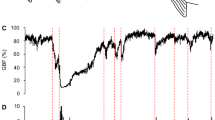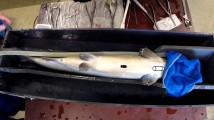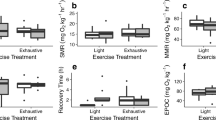Abstract
The introduction of ‘Catch and Release’ fishery programs are now widely employed by fisheries managers in most Atlantic Provinces, primarily due to the recent decline of Atlantic salmon stocks on the east coast of Canada. However, there is still considerable debate among special interest groups and regulators as to the effectiveness of the technique. Heart rate telemetry has been utilized as a tool for the assessment of metabolic rate in wild fish by a number of investigators, and was employed in the present study in order to assess recovery following staged angling events in Atlantic salmon. Wild Atlantic salmon were successfully angled at 20 ±2 °C and 16.5 ±1 °C at Noel Paul's Brook, Newfoundland. In addition, hatchery reared Atlantic salmon were angled at the Ontario Ministry of Agriculture and Fisheries Research Station, Alma, Ontario, at a temperature of 8 ±1 °C. Survival rate for the angled salmon was 20% at 20 ± 2 °C; 100± at 16.5 ±1 °C; and 100% at 8 ± 1 °C. Mean resting heart rate for the fish angled at 16.5 °C and 20 ° C was approximately 1.6 and 1.8 times greater than that of fish angled at 8 °C. Heart rate, post angling, was found to increase 1.2 fold in the 8 °C group, 1.3 fold in the 16.5 °C group and approximately 1.15 fold in the 20 °C group. Time to recovery was assessed as a return to observed resting heart rate for each individual fish and was found to be similar for both the 8 °C and 16.5 °C angled groups (approximately 16 h). Although heart rate telemetry in fish is, perhaps, not an ideal measure of metabolic rate, the present study has demonstrated that remote monitoring of heart rate is a good indicator of post exercise physiological activity.
Similar content being viewed by others
Explore related subjects
Discover the latest articles and news from researchers in related subjects, suggested using machine learning.References
Anderson, W. G., R. S. McKinley & M. Colavecchia, 1997. The use of clove oil as an anesthetic for rainbow trout and its effects on swimming performance. North am. J. Fish. Mgmt 29: 301–307.
Armstrong, J. D., 1986. Heart rate as an indicator of activity, metabolic rate, food intake and digestion in pike, Esox lucius. J. Fish Biol. 29: 207–221.
Barnhart, R. A., 1989. Symposium review: Catch and release, a decade of experience. North am. J. Fish. Mgmt 9: 74–80.
Beggs, G. L., G. F. Holeton & E. J. Crossman, 1980. Some physiological consequences of angling stress in muskellunge, Esox masquinongy Mitchell. J. Fish. Biol. 17: 649–659.
Bielak, A. T., 1996. A discussion document on the implications of catch and release angling for Atlantic salmon, with particular reference to water temperature related river closures. DFO, Atlantic Fisheries Research Document, 96/117, 17 pp.
Booth, R. K., J. D. Kieffer, K. Davidson, A. T. Bielak & B. L. Tufts, 1995. Effects of late-season catch and release angling on anaerobic metabolism, acid-base status, survival, and gamete viability in wild Atlantic salmon (Salmo salar). Can. J. Fish. aquat. Sci. 52: 283–290.
Bouck, G. R. & R. C. Ball, 1966. Influence of capture methods on blood characteristics and mortality in the rainbow trout (Salmo gairdneri). Trans. am. Fish. Soc. 95: 170–176.
Claireaux, G., D. M. Webber, S. R. Kerr & R. G. Boutilier, 1995. Physiology and behaviour of free-swimming Atlantic cod (Gadus morhua) facing fluctuating temperature conditions. J. exp. Biol. 198: 49–60.
Farrell, A. P., 1982. Cardiovascular changes in the unanaesthetised ling cod (Ophiodon elongatus) during short term progressive hypoxia and spontaneous activity. Can. J. Zool. 60: 933–941.
Farrell, A. P. & D. R. Jones, 1992. In W. S. Hoar, D. J. Randall & A. P. Farrell (eds), Fish Physiology, Academic Press Inc. New York. 12A: 1–73.
Ferguson, R. A. & B. L. Tufts, 1992. Physiological effects of brief air exposure in exhaustively exercised rainbow trout (On-chorhynchus mykiss): implications for ‘catch and release’ fisheries. Can. J. Fish aquat. Sci. 49: 1157–1162.
Gamperl, A. K., M. M. Vijayan & R. G. Boutilier, 1994. Epinephrine, norepinephrine, and cortisol cocentrations in cannulated seawater-acclimated rainbow trout (Onchorhynchus mykiss) following black-box confinement and epinephrine injection. J. Fish Biol. 45: 313–324.
Graham, W. D., J. E. Thorpe & N. B. Metcalfe, 1996. Seasonal current holding performance of juvenile Atlantic salmon in relation to temperature and smolting. Can. J. Fish. aquat. Sci. 53: 80–86.
Graham, M. S., C. M. Wood & J. D. Turner, 1982. The physiological responses of the rainbow trout to strenuous exercise: interactions of water hardness and environmental acidity. Can. J. Zool. 60: 3153–3164.
Harder, W., 1975. Anatomy of Fishes. Parts I and II. E. Schweizer-bart'sche Verlagsbuchhandlung, Stuttgart.
Johnstone, A. D. F., M. C. Lucas, P. Boylan & T. J. Carter, 1992. Telemetry of tail beat frequency in Atlantic Salmon (Salmo salar) during spawning. In I. M. Priede & S. W. Swift (eds), Wildlife Telemetry, Ellis-Horwood, New York: 456–465.
Kaseloo, P. A., A. H. Weatherly, J. Lotimer & M. D. Farina, 1992. A biotelemetry system recording fish activity. J. Fish Biol. 40: 165–179.
Lucas, M. C., 1994. Heart rate as an indicator of metabolic rate and activity in adult Atlantic salmon, Salmo salar. J. Fish Biol. 44: 889–903.
Lucas, M. C., I. G. Priede, J. D. Armstrong, A. N. Z. Gindy & L. De Vera, 1991. Direct measurement of metabolism, activity and feeding behaviour of pike (Esox lucius) in the wild by use of heart rate telemetry. J. Fish Biol. 39: 325–345.
Milligan, C. L. & C. M. Wood, 1986. Tissue intracellular acid-base status and the fate of lactate after exhaustive exercise in the rainbow trout. J. exp. Biol. 123: 123–144.
Moore, A., E. C. E. Potter, N. J. Milner & S. Bamber, 1995. The migratory behavior of wild Atlantic salmon (Salmo salar) smolts in the estuary of the River Conway, North Wales. Can. J. Fish. aquat. Sci. 52: 1923–1935.
Nelson, J. A., Y. Tang & R. G. Boutilier, 1996. The effects of salinity change on the exercise performance of two Atlantic cod (Gadus morhua) populations inhabiting different environments. J. exp. Biol. 199: 1295–1309.
Peake, S. & R. S. McKinley, 1997. A re-evaluation of swimming performance in juvenile salmonids relative to downstream migration. Can. J. Fish. aquat. Sci. (in press).
Priede, I. D., 1974. The effects of swimming activity and section of the vagus nerve on heart rate in rainbow trout. J. exp. Biol. 60: 305–319.
Priede, I. D. & P. Tytler, 1977. Heart rate as a measure of metabolic rate in teleost fishes Salmo gairdneri, Salmo trutta and Gadus morhua. J. Fish Biol. 10: 231–242.
Rimmer, D. M., R. L. Saunders & U. Paim, 1985. Effects of temperature and season on the position holding performance of juvenile Atlantic salmon, Salmo salar. Can. J. Zool. 63: 92–96.
Stevens, E. D., G. R. Bennion, D. J. Randall & G. Shelton, 1972. Factors affecting arterial blood pressure and blood flow from the heart in intact, unrestrained ling cod, Ophiodon longatus. Comp. Biochem. Physiol. 43: 682–695.
Thorarensen, H., P. E. Gallaugher & A. P. Farrell, 1996. The limitations of heart rate as a predictor of metabolic rate in fish. J. Fish Biol. 49: 226–236.
Tufts, B. L., Y. Tang, K. Tufts & R. G. Boutilier, 1991. Exhaustive exercise in wild Atlantic salmon (Salmo salar): Acid-base regulation and blood gas transport. Can. J. Fish. aquat. Sci. 48: 868–874.
Wilkie, M. P., K. Davidson, M. A. Brobbel, J. D. Kieffer, R. K. Booth, A. T. Bielak & B. L. Tufts, 1996. Physiology and survival of wild Atlantic salmon following angling in warm summer waters. Trans. am. Fish Soc. 125: 572–580.
Wood, C. M., J. D. Turner & M. S. Graham, 1983. Why do fish die after severe exercise? J. Fish. Biol. 22: 189–201.
Rights and permissions
About this article
Cite this article
Anderson, W.G., Booth, R., Beddow, T.A. et al. Remote monitoring of heart rate as a measure of recovery in angled Atlantic salmon, Salmo salar (L.). Hydrobiologia 371, 233–240 (1998). https://doi.org/10.1023/A:1017064014274
Issue Date:
DOI: https://doi.org/10.1023/A:1017064014274




